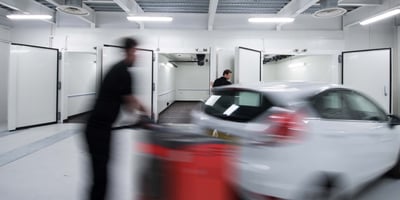How do you move cars around your testing facility without contaminating the results of ongoing emission tests? Or speed up the painstaking process of calibrating ADAS testing parameters? Two experts from SEMA Garage in Detroit share insights and trends from the frontline of automotive testing.
SEMA (the Specialty Equipment Market Association) provides business tools and resources to more than 6,500 companies in all automotive industry segments. The organisation’s garages function as product development centres, where member businesses get access to high-tech equipment and services such as 3D scanning, emissions testing, and more.
The summer of 2022 saw the grand opening of SEMA Garages’ new 4,200 m² facility in Detroit, Michigan. This is the first-ever research centre dedicated to understanding the impact of Advanced Driver Assistance Systems (ADAS) from an aftermarket perspective.
To get this industry frontrunner’s view on the rapid development in today’s testing landscape, we talked to Benjamin (“Ben”) Kaminsky, General Manager, and Mike Muller, Aftermarket ADAS Engineer.
What are the most significant changes in the mobility space today?
Mike: “As far as transportation goes, the electrification, hybrids, hydrogen, all of those new technologies are going to allow us to open up new doors of multimodal transportation.”
Ben: “There are other aspects as well, with different vehicles and ownership of vehicles versus buying ride shares and so on.”
What role does the SEMA Garage play in this development?
Mike: “What we do for our members is provide an environment where they can research and develop new products to enable those opportunities to happen, for them and for the industry.”
Ben: “We focus mainly on the aftermarket and aftermarket performance industry. For us, it's about personalisation of the vehicle that people own.”
In terms of engine technology, where is the industry headed?
Ben: “We're excited about the breadth of the technology available today. For our grand opening, we had a hydrogen-powered, supercharged VA truck. We had electric vehicles, both modified from ICE and ones that came out of the factory as BEVs. And the traditional ICE engines as well. We're not trying to pick which one the performance enthusiasts or the industry might go with in the end, but we're looking to help enhance the experience for everyone.”
 How far away is automated driving from becoming mainstream?
How far away is automated driving from becoming mainstream?
Ben: “Vehicle autonomy is a really cool innovation and idea, and I think the technology will keep pushing in that direction. But legislatively, there's still a long way to go in terms of people's safety and who’s liable if a vehicle makes the wrong decision.”
What are you personally really passionate about?
Mike: “We need innovation to push through all of the obstacles and challenges of future developments. There's always something new and next in this industry. For example, all our vehicle data now goes to the cloud, letting us track vehicles and do things that benefit the masses. These new technologies are saving people's lives, making transportation easier, more comfortable, and more enjoyable for different types of drivers. What really excites me is to start something from nothing and see some fruition at the end that makes things better, cheaper, faster, and more fun.”
Ben: “What really excites me about our industry is taking something old and then applying some of the new technologies to it. Whether it's suspension, performance parts, or the camera systems that are on vehicles now that you can buy in the aftermarket. Being able to help our members solve problems is really cool.”
How does Stringo’s electric vehicle mover support your mission?
Ben: “We use it a lot in our day-to-day work. We can't be running vehicles in the shop because it impacts the outcome of our tailpipe emissions test. So Stringo helps us be able to move those vehicles on and off the emissions dynamometer and around the facility without any emissions in the area.”
What’s next in your partnership with Stringo?
Ben: “At the moment, we’re having a lot of fun ideating with the Stringo team on how we could use the vehicle mover to speed up our calibration process for ADAS testing. For example, when you calibrate a forward-facing camera in a static position, you spend a long time just measuring and making sure the vehicle is in the right position relative to the targets. By using the vehicle mover in tandem with those targets, we hope to be able to place the vehicle to the target much more quickly.”
Looking for more inspiring stories? Don’t miss this interview with Toby Stinson, the event manager for a classic car charity auction that helps fund the Owl’s Head Transport Museum in Maine.






